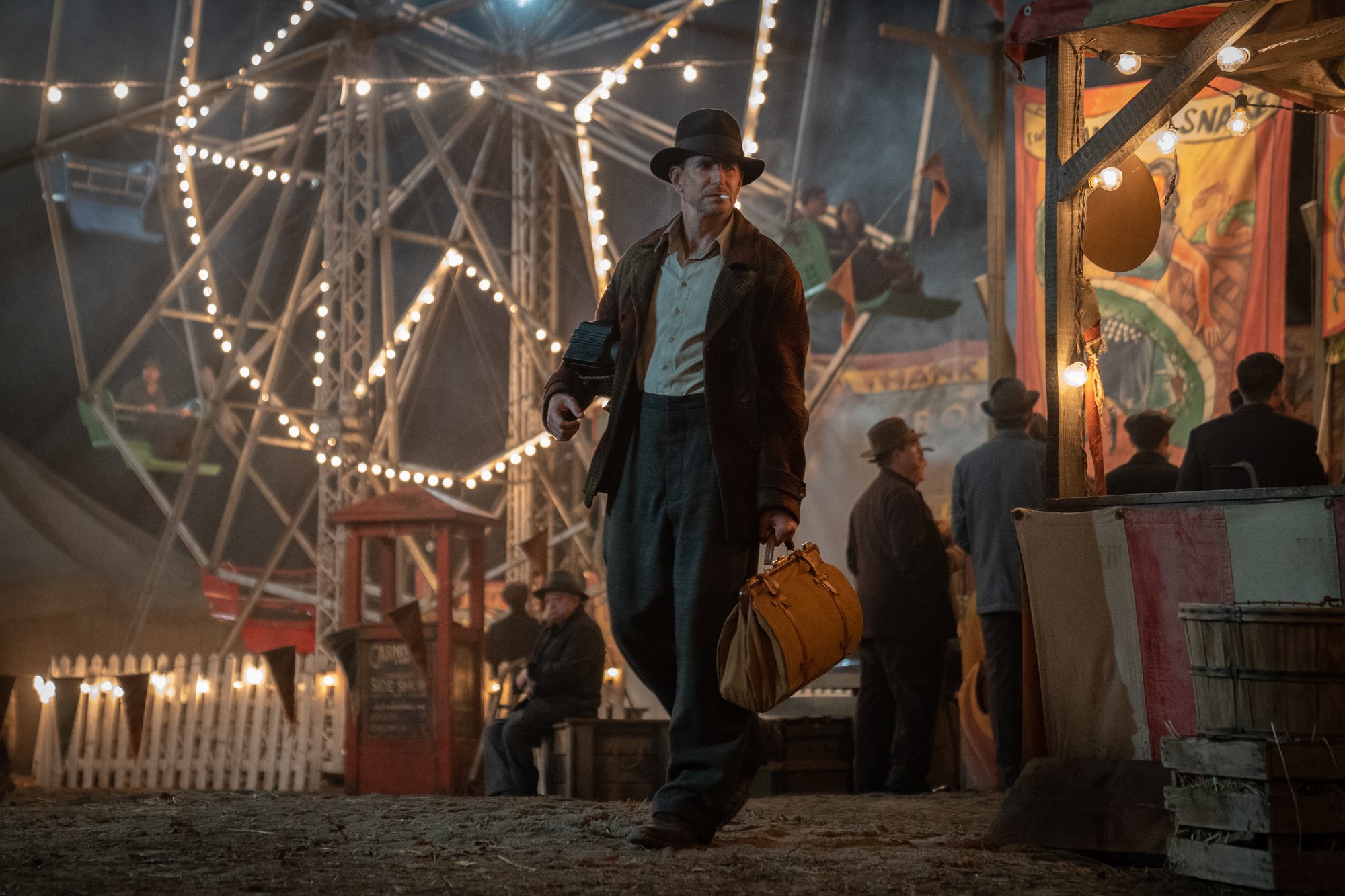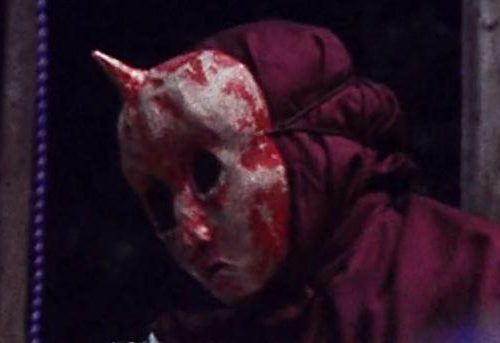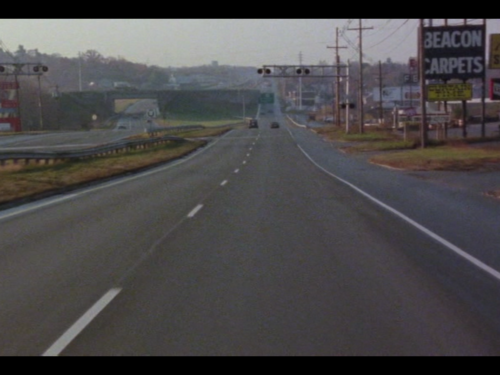Editors note: This is a full film analysis and therefore contains spoilers.
Guillermo del Toro’s signature thematic and aesthetic love for the monstrous and the divine, the perverse and the absurd, and the shades of gray that color the heroic and the villainous is inscribed in each frame of Nightmare Alley (2021), but the film is the director’s first experimentation with the cruel and despairing ethos of film noir. Adapted from William Lindsay Gresham’s 1946 novel of the same name, Nightmare Alley follows the macabre journey of Stanton Carlisle (Bradley Cooper), a drifter who unexpectedly makes his way to a carnival. Stan is drawn to a particularly horrid attraction: “The Geek,” a man, who can scarcely be called even that given his destitute conditions, who is prodded to scandalize audiences. The carnival boss, Clem (Willem Dafoe), teases the question “Is he man or beast” as the geek, incapable of speaking and caked in his own blood and filth, is fed a live chicken that he clings desperately to. Stan is moved more by pity and curiosity than he is by horror. Clem seems to understand the drifter’s attraction to the carnival environment and invites him to join their outfit.
Although he initially joins to help Clem in the maintenance of the carnival, Stan has bigger ambitions in mind. He finds himself smitten with Molly Cahill (Rooney Mara), a waif of a young woman who dazzles and titillates audiences by running an electric current through her half-naked body. But Stan is drawn even more intensely to a once-great mind reading act, helmed by husband and wife team Zeena (Toni Collette) and Pete (David Strathairn). The two take Stan under their wing and teach him the artistry of mentalism. During this time, Stan comes to understand the emotional toll of their work: Pete has fallen into alcoholism and Zeena is left to carry the act on her own, until the night Pete drinks a bottle of wood alcohol (literal poison) that Stan provides him, and dies.
Related: Guillermo Del Toro’s Cronos (1993): Eternal Moments by Frankie Vanaria
Soon thereafter, Stan and Molly leave the carnival to make it on their own, using Pete’s and Zeena’s act in New York City. For two years, the carnies captivate upscale audiences with the performance. Blindfolded, Stan waits for Molly to collect questions written by the members of the audience, and she reads them to him in a coded language that gives him the information he needs about the person asking the question; meanwhile, Stan intones mysteriously and makes it seem that he is pulling his answers from the ether. One night, they encounter the enigmatic psychologist Dr. Lilith Ritter (Cate Blanchett), who is in attendance with the powerful Judge Kimball (Peter MacNeil). Lilith quickly understands how the trick works and attempts to throw Stan off by asking the questions herself, denying Stan the clues he needs to make the audience trust his abilities as a seer. Quick on his feet and observant, Stan gets the better of Lilith in this moment, but it is just the beginning of their relationship. Stan later approaches Lilith with the prospect of teaming up to bilk wealthy and gullible marks out of their money. Through her work, Lilith is connected to the New York elite and can feed Stan information about them that he can use for private “spook shows” in which he pretends to commune with the deceased loved ones of his patrons. This eventually leads to Stan’s work with Ezra Grindle (Richard Jenkins), who is haunted by the memory of a young woman whose death he was responsible for. However, plans go awry and Stan finds himself back where he started.

Stan is a unique protagonist in del Toro’s pantheon. In so many of his films, del Toro’s characters find a certain redemption and grace by the end of their journeys. There is, for instance, the Mexican antiques-dealer-turned-vampire who kills himself rather than drink the blood of a loved one in Cronos (1993). In The Devil’s Backbone (2001), set during the Spanish Civil War, a child’s ghost finds peace after seeing his murderer killed. The deaf-mute heroine of The Shape of Water is murdered and then resurrected, passing from a life of loneliness to one of bliss as she is reunited with the fish god in the ocean. From the first moments of Nightmare Alley to its last, Stan is weighed down by a past that he cannot escape. Contrary to del Toro’s other films, which all begin with voiceover narration, Nightmare Alley begins in almost complete silence: We hear only Stan in the midst of dragging a bag with a body stuffed into it across a bare floor; in a moment he will bury it under the floorboards and light the house on fire, as he makes for the bus that will fatefully lead him to Clem’s carnival. This scene depicts the original sin that imprisons Stan throughout his journey from carnie to nightclub showman and back to the carnival again. Del Toro periodically flashes back to this memory, revealing more as the film unfolds and we understand that the body in the bag is Stan’s father, who Stan murdered out of a deep hatred for him.
Stan sees his father as an incredibly passive and shameful man, a victim of the decisions made by other people and someone incapable of holding on to what he has. Stan confesses to Lilith that his mother left him and his father for another man, and since then Stan vowed to not become weak like his father. Therefore, Stan demonstrates an existential need to stay ahead of everyone else, which is why it’s important that he is able to look at someone and know what they want. As long as he does this, Stan can remain in control, he thinks, and he can’t be taken off guard. But the irony of Stan’s situation is precisely that he is not in control, and he does not realize it. He is a cosmic joke who thought he could stay ahead of everyone else. But by the film’s end, when his plans fall through and he is forced to “geek” for a new carnival boss (Tim Blake Nelson), Stan affirms that he is just as powerless to change his circumstances as his father was. In a poignant turn, Stan’s life will end just as ignominiously as his father’s: Even if Stan is not murdered, when he does die he will simply be thrown away and forgotten, with no one caring who he was other than a monstrosity who made the carnival some money.
Stan is a cold and callous man who is nevertheless charming enough to win people over. In many ways, Stan cares little for anyone’s life but his own. But part of what is so impressive about del Toro’s work is that Stan scans as a deeply human and tragic character who warrants sympathy from the audience. One of the most surprising and touching aspects of the film is Stan’s relationship with Clem’s geek. One could easily imagine that Stan would have no regard for such a pathetic creature; however, he sees the geek as someone deserving of sympathy. We see this first when the geek breaks loose and Stan finds him hiding in the fun house. In his first words of the film, Stan tells the cowering wretch that he won’t call anyone on him because the geek never did anything to him; he just has to come out of hiding. Stan approaches the geek with a touching humanity. He knows that the miserable soul wants to be free and he does not want the geek to be overwhelmed or traumatized by having everyone descend on him. If the geek’s fate is to be imprisoned in this hellish carnival, Stan wants to ease him back into it. At least, this is the case at first. Once the geek attacks Stan and tries to flee, Stan beats him so severely that Clem has to chastise him for nearly killing the geek. Clem denies the geek even an ounce of humanity, but he needs him alive for the show. After Stan has spent some time with the carnival, he hears the geek wailing in the middle of the night. In another surprising demonstration of the humanity he affords to the geek, Stan offers him a cigarette, which the geek kindly accepts. It is hard to think of any of the other members of the carnival doing this for the geek. Even in a community of freaks and social outcasts, the geek is kept at a distance. When the geek begins to succumb to the head wound, Stan and Clem dump him in a back alley. Stan expresses some consternation over just abandoning the geek, but Clem dismisses him and they rush out. Stan continues to be dismayed in the scene after this, but Clem is unaffected and explains to his protege how to get a broken man to geek for the promise of a job and a few sips of alcohol. In time, Stan will come to fully understand this lesson.

It’s never quite clear why Stan looks at the geek with sympathy. Perhaps Stan sees something familiar in the geek. After all, the creature is reduced to a life of bare survival and powerlessness, so it is not hard to imagine that Stan sees something of his pathetic father in the geek. Or, perhaps Stan sees himself in the geek, his fear of suffering his father’s same fate reflected back at him. In any event, it is no mystery where the geek is a source of concern for del Toro, himself a lapsed Catholic. The geek’s life is something that can only be a feature of a world that has been abandoned by God, where there is no prospect for the redemption of humanity or the renewal of the human spirit. The geek is nothing other than a creature that has been stripped of its humanity and left to wither and die while being gawked at by indifferent crowds.
The geek’s desperation and abandonment is not particular to him, however, or even to Stan’s descent over the course of Nightmare Alley. These are some of the defining themes of horror cinema and film noir, both of which have roots in the aesthetics of German Expressionism. High contrast lighting, tilted camera angles, and disturbing costumes and sets represented the visual conventions of classical Hollywood horror in films such as Frankenstein (1931) and Dracula (1931). Film noir married the visuals of German Expressionism to a post-war sentiment of paranoia and moral darkness in America. The crime environment of noir — in films like Double Indemnity (1944), Detour (1945), Crossfire (1947), and The Lady from Shanghai (1947) — exposes humanity’s blackest of hearts. Men, driven by libidinal desire and the promise of monetary gain, conspire with women of ill-repute who eventually betray them and lead to their joint downfall. It is in the parameters of film noir that characters indulge their most antisocial tendencies. And in so doing they demonstrate the depths of humanity’s capacity for cruelty — as well as the pointlessness of one human being’s indifference to the welfare of others, since the protagonists of these stories constantly live in fear of the moment when they lose all that they have acquired. Film noir’s protagonists are not very different from the geek at all. They twist and turn and squeal in their cages, trapped by their criminal choices and their inability to change the fate of death and deprivation that awaits them.
The Stan of the original Nightmare Alley adaptation, directed by Edmund Goulding and released in 1947, is similarly driven by hubris toward his own damnation. In Goulding’s version, screen icon Tyrone Power gives Stan a cunning and heartless edge that is somewhat lacking in Bradley Cooper’s portrayal of the character. In the earlier version, there is a scene where Stan tries to convince Molly to pretend to be the ghost for Ezra Grindle, in one last push for his money. Stan tells Molly that he has always been honest with her, even if he will and does betray everyone else in the world. Molly desperately wants these words to be true, but as Stan speaks them we can see on his face that they are not — but it doesn’t matter, because we can see that he has brought Molly back to him. Del Toro and Cooper, though, diminish this element of malevolence in Stan’s character, and in so doing cast him in a slightly more sympathetic light. Stan is still manipulative and violent in the del Toro/Cooper version, but Stan carries a certain sadness in this new version: Though he is always trying to stay one step ahead of everyone else, we know that there is a horrible deed in Stan’s past that will always keep him from going as far as he wants to. The Stan of del Toro’s film seems to know this, too.

At the end of both adaptations, Stan returns to the carnival to become the geek after years of success with his and Molly’s mentalist act. In Goulding’s version, Molly comes back to the con man out of a mixture of pity and love for him. A delirious Stan, tormented in his new role as the geek, considers gentle Molly standing in front of him for a few moments and slowly regains his composure. There is hope that Stan can, with Molly’s help, pull himself back from the edge. The Stan of del Toro’s version does not have this opportunity. Molly does not return to her former lover, which truly leaves Stan with nothing other than the carnival and his new role as the geek. The carnival could have been a way for Stan to start over. When he first arrives, Clem tells him that it’s the kind of place where people don’t care about your past, which appeals to Stan, as he may be able to put the murder of his father behind him. Only too late does Stan seem to understand the flip side of what Clem proposed in welcoming Stan into their group. That is, when Stan returns to the carnival, no one asks about his past because no one recognizes him or cares who he is, and he appears only as a homeless and disheveled drunk needing work and a place to stay. Had the carnival originally been enough for him, perhaps things would have turned out differently for him. Perhaps.
Then again, the theme that runs throughout del Toro’s Nightmare Alley is entrapment and imprisonment — as if one were caught in the rotation of the carnival’s ferris wheel, or a carousel that never stops spinning. (It is on a carousel that Stan first courts Molly.) We see this much in Stan’s journey: He finds the carnival, only to leave it and return to it; he kills his biological father and then kills his figurative one in Pete; Stan tries to bring Lilith in on his deceptions, simply to find that she was the one trapping him all along. But Nightmare Alley is filled with other allusions to entrapment as well. For one, there is Lilith’s audio recording machine, which she uses to tape all of her sessions with her patients. These recordings provide Stan with useful information on Ezra to reel him in deeper. But this machine also becomes the con man and thief’s downfall when Lilith reveals that she will use recordings of her sessions treating Stan to make him seem in need of serious psychiatric care and institutionalization, should he make threats against her. It is somewhat strange that Stan, knowing that Lilith has this device, agrees to therapy sessions with her; he even expresses concern that she is recording the first conversation they have in her office, when he learns about the device. However, this detail is consistent with Stan’s outlook on the world, of how he sees others — his father, the geek, Lilith’s other patients — as vulnerable or capable of being trapped in their circumstances, but never himself.
True to his sensibilities, and the ethos of German Expressionism and film noir, del Toro includes a visual metaphor in Nightmare Alley that reflects and exaggerates his protagonist’s emotional and spiritual crisis. Stan’s sense of imprisonment is communicated by a curiosity that Clem keeps: Pickled babies, animal and human. Clem tells Stan about his special one, named Enoch, whose mother died in childbirth, giving birth to a demonic looking baby with a third eye in the middle of its forehead, which passively returns the stare of anyone looking at it. Stan is fascinated by Enoch and does not understand that in looking at it, he is also staring back at himself. Stan is already trapped, already damned. Clem informs Stan that the baby “flopped around” for a few days after its birth and its mother’s death — it’s a horrifying, but oddly poignant sentiment. Not just for Stan, but as an encapsulation of what film noir stands for and what it tells all of us about ourselves: We’re all just flopping around for a few days after we’re born.
Find Nightmare Alley on your preferred streaming service
Stay up to date with all things Split Tooth Media and follow Frankie on Twitter
(Split Tooth may earn a commission from purchases made through affiliate links on our site.)




